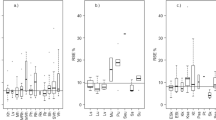Abstract
An observational design technique supporting water quality modelling was reviewed and evaluated. The practical feasibility and mathematical sensitivity of the method were analysed for Lake Kuortaneenjärvi, Western Finland. A sampling programme to estimate characteristic rate parameters for competition between the nitrogen-fixing cyanobacter Aphanizomenon flos-aquae and eukaryotic phytoplankton was produced and the robustness of the design with respect to parameters and input was studied using the Monte Carlo technique. Optimal timing of observations appeared to be more sensitive to noise in the parameter values than to stochasticity in the model input, which consisted of data on the nutrient loading and climatic conditions of the lake. The perturbated parameter values favoured the weighting of phytoplankton dynamics, whereas the perturbations of the input shifted the design towards cyanobacterial dominance. It was concluded that this was because correct timing of algal succession was the most crucial element in successful estimation. Considerable rationalization of the use of measurement resources can be achieved by adopting the design procedure. This was also demonstrated for Lake Kuortaneenjärvi.
Similar content being viewed by others
References
Beck, M. B., 1983. A procedure for modeling. In Orlob, G. T. (ed.), Mathematical Modeling of Water Quality. Streams, Lakes and Reservoirs. IIASA. John Wiley & Sons, New York: 11–41.
Box, G. E. B. & N. R. Draper, 1987. Empirical Model-building and Response surfaces. John Wiley & Sons, New York, 669 pp.
Fedorov, V. V., 1972. Theory of Optimal Experiments. Academic Press, New York.
Kettunen, J., 1993. Design of limnological observations for detecting processes in lakes and reservoirs, In M. Straskraba, M. Tundisi & A. Duncan (eds), Comparative Reservoir Limnology and Water Quality Modelling. Developments in Hydrobiology 77. Kluwer Academic Publishers, Dordrecht (in press).
Kettunen, J., H. Sirviö & O. Varis, 1988. An analysis of a sampling design — a case study of lake eutrophication. Computational Statistics and Data Analysis. 8: 81–91.
Silvey, S. D., 1980. Optimal Design. Chapman and Hall, London, 86 pp.
Varis, O., 1984. Water quality model for Lake Kuortaneenjärvi, a polyhumic Finnish lake. Aqua Fennica 14: 179–187.
Varis, O., 1988. The temporal sensitivity of Aphanizomenon flos-aquae dominance — a whole-lake simulation study with input perturbations. Ecological Modelling 43: 137–153.
Varis, O., 1990. Impacts of growth factors on competitive ability of blue-green algae analyzed with whole-lake simulation. In M. Straskraba, M. Tundisi & A. Duncan (eds), Comparative Reservoir Limnology and Water Quality Modeling. Developments in Hydrobiology 77. Kluwer Academic Publishers, Dordrecht (in press).
Author information
Authors and Affiliations
Rights and permissions
About this article
Cite this article
Kettunen, J., Sirviö, H. & Varis, O. Evaluation of a model-based method for designing water quality observations. Hydrobiologia 243, 381–387 (1992). https://doi.org/10.1007/BF00007054
Issue Date:
DOI: https://doi.org/10.1007/BF00007054




